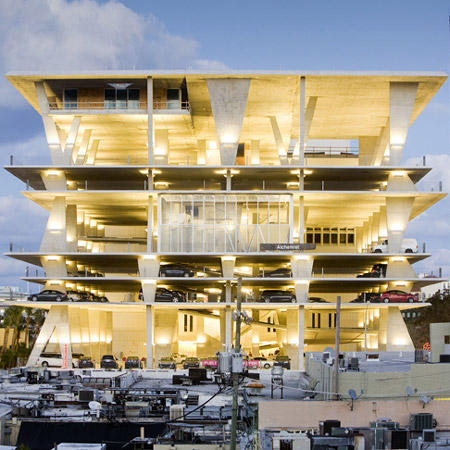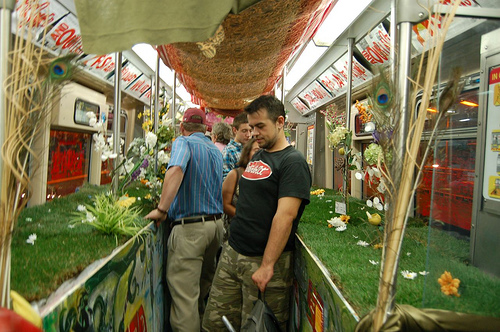A number of recent articles and threads of exploration have gotten me thinking about the importance of the role of the arts and design in transforming our everyday life. I think we are moving toward an era where the traditional enjoyment of art (performing or visual) in a passive way in a facility/space constructed expressly for that purpose will not die, but will find itself joined (perhaps surpassed) by art that subversively injects itself into our everyday life - you don't make the choice to participate. It chooses you - it is an intervention that is unexpected. This can be disturbing, delightful, inspiring, sometimes all at the same time. I have written before about the "arts flash mob"phenomenon and its visual arts equivalent (which would include some of what we might consider "street art"), here, and here, and here.

Here are a few of the items that have inspired me recently to think about this more deeply. Paul Goldberger reviews in the current New Yorker the new Herzog and deMeuron building in Miami (image above; photographer - Nelson Garrido, from www.dezeen.com ). What is this new structure by this great international architecture team? A parking garage! That most ubiquitous of urban structures that is generally accepted as truly deadening to the built environment. Yet H&dM make it a thing of beauty - light, airy, modern, a work of art.
So now that most ordinary act of parking your car in an urban garage can in a sense immerse you in an artistic experience. Similarly, one of the new initiatives of the Mural Arts Program is to cover almost the entire exterior of the large (ugly, traditional) parking garage at Philadelphia International Airport in a mural called "How Philly Moves."
And while we are on the subject of the impact art and architecture can have on the design of "mundane" spaces, this article from Fast Company highlights an array of arresting restaurant designs (sorry, couldn't resist the alliteration) from around the world - most of which are artist-designed "interventions" that create temporary dining pavilions where the space itself shapes the dining experience as much as the food.
If you look at the schedule of the Live Arts-Philly Fringe Festival you will also find that much of the work is breaking the boundaries of "traditional art," not just in form and content, but in location and the very relationship between the art and the audience. Last year's festival featured a dance piece performed in an abandoned swimming pool. The Maine Center for Creativity has initiated a project called Art All Around, that will involve painting the entire surface of 8 huge oil storage tanks (plus the tops of 8 more), so now that classic American experience of driving by "tank farms" (think New Jersey Turnpike near Newark Airport) can be transformed into a startling encounter with art.
The French artist JR has transformed favelas in Rio De Janeiro, and other poor communities around the world with his photography-based art. There is now an effort underway by the artist team Haas&Hahn, with the Firmeza Foundation to literally transform an entire favela into a work of art. If successful, the poorest most disenfranchised Brazilians will be literally living within one massive work of art. It may not put food on their tables, but it will bring beauty into their lives and attract international attention to their living conditions.
In Chicago you have "Art on Track" that since 2008 has annually transformed an entire 8-car Chicago Transit Authority train into a rolling art gallery. (photo below. Chicago Art on Track, a Creative Commons Attribution Non-Commercial No-Derivative-Works (2.0) image from chicagoceli's photostream)

I think a number of factors are driving this phenomenon and will continue to fuel it. One is the democratization of art. New generations of artists and audiences don't want to be elitist, to limit their work or their cultural experience to an ivory tower or a price point that leaves out a huge section of the population.
Another is the growing interest in interactive work, in the process of creation, especially among younger people. And finally I think those that are in the business of making and presenting art are desperate to reach a broad audience and find it increasingly difficult to reach them just in the theatre or in the museum. So they seek ways to put their art in the street, in train stations, in sports stadiums, along the highway, in supermarkets.
I for one think this is a healthy trend. This is not just about Web 2.0 and new technology; this is about a whole new approach to the relationship between art and audience. This is about making our everyday life more arts-infused.